
戦略ストーリーはどのように進化するのか?
前回の記事では、戦略ストーリーに一貫性をもたらすコンセプトが、どのように生み出されるのかについてお話ししました。
戦略ストーリーにおいて新しい価値要素が創造される起点は、コンセプトが意識されることにあります。そして、そのコンセプトをもとに新しい価値要素が生み出されるためには、何段階かのプロセスを踏むことになります。今回はこのプロセスについて説明していきます。
戦略ストーリー進化のステップと、価値創造プロセスの位置付け
まずは、戦略ストーリーをつくることの全体像を確認するために、戦略ストーリーの5つの進化ステップをおさらいしましょう。
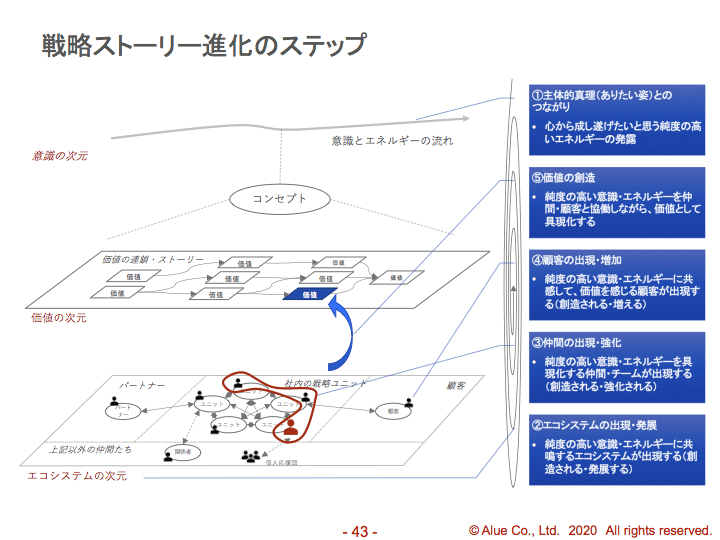
これまでの記事において、戦略ストーリー進化のステップの①〜④までを説明してきました。こちらについて知りたい方はこちらの記事をご参照ください。
ステップ①〜④を経て、いよいよ⑤の「価値の創造」ステップになります。この価値の創造を行うためには、戦略ストーリー全体の一貫性を担保するコンセプトを持つことが大前提となるということを前回の記事でお話ししました。
明確になっているコンセプトにつながりながら、新しい価値要素を創造するプロセスが「価値創造プロセス」です。これから「価値創造プロセス」についてお話ししていきますが、その前に、このような疑問に答えておく必要があるように思います。
「戦略ストーリー進化のステップがある中に、さらに詳細な価値創造プロセスがあるというのはどういうこと?」

このような疑問をもつことはとても自然なことと思います。私も、殊更に複雑にするのではなく、なるべくシンプルにお伝えすることが大切と思っています。
しかし、以前の記事でもお話ししましたが、いい戦略を「理解すること」と「つくること」のギャップを埋めるためには、戦略ストーリー進化のステップの中に、さらに詳細なプロセスを記述する必要があると判断しました。
「戦略を理解する」ときには、マクロ的・結果的・積分的に捉えることができれば十分ですが、「戦略をつくる」ときには、ミクロ的・原因的・微分的な感覚が伴う必要があるからです。
自動車で旅行にいくメタファーで表現すると次のような感じです。旅行の目的地を「いい戦略をつくること」とすれば、その目的地につくためには自動車をあるスピードで走らせる必要があります。そのスピードにあたるものが、「戦略ストーリー進化のステップ」です。そして、自動車をあるスピードで走らせるためには、アクセルを踏む必要があります。そのアクセルにあたるものが、今回ご紹介する「価値創造のプロセス」です。
いい戦略をつくることを、自動車で旅行に行くメタファーで表現する
旅行の目的地(道のり)・・・いい戦略をつくること
自動車のスピード(速度、一次微分)・・・戦略ストーリー進化のステップ
アクセルを踏むこと(加速度、二次微分)・・・価値創造のプロセス

旅行の目的地にいくためには、自動車のアクセルを踏む必要があります。そして、自動車のアクセルを踏むということは、体内感覚に近いものであり、「やろうと思えばできること」になります。
いい戦略をつくるということもこれと同じで、体内感覚に近く、「やろうと思えばできること」というレベルで、ミクロ的・原因的・微分的に捉える必要があると思っています。
そして、ミクロ的・原因的・微分的に捉えるということは、意識の使い方を意識化することであるということは、これまでも繰り返しお伝えしてまいりました。これからご説明する「価値創造のプロセス」も、意識の意識化という世界観で捉えています。
価値創造の6つのプロセス
価値創造プロセスは、次の6つに分けられます。各プロセスにおいて活性化する意識を、3+1意識モデル上に番号で示しています。
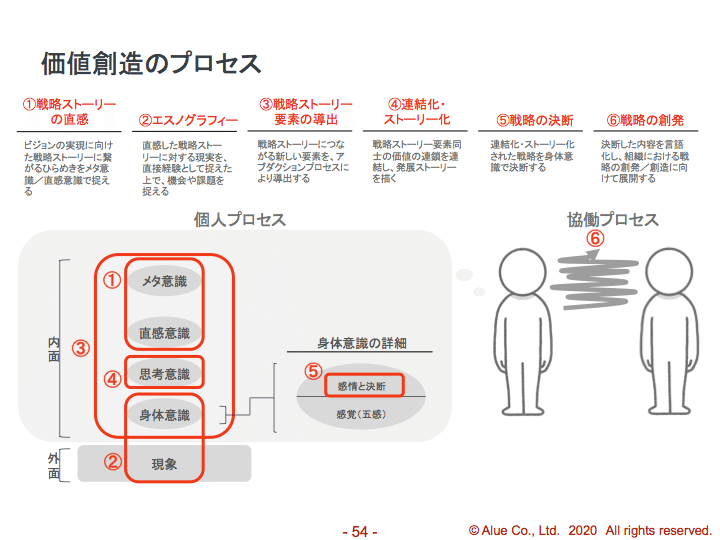
6つのプロセスについてご理解いただくために、各プロセスの概要をこれからご説明したいと思います。また、内容を抽象的に説明するだけではなく、具体事例をご紹介することで理解を深めていきたいと思います。
まずは、価値創造プロセスの始まりとなる「直感の活用」です。
価値創造には直感を活用することが大切
①戦略ストーリーの直感:
ヴィジョンの実現に向けた戦略ストーリーに繋がるひらめきをメタ意識/直感意識で捉える
最初のプロセスでは、ヴィジョンあるいはコンセプト(アイデンティティ+コアバリュー)の実現に向けた戦略ストーリー上の価値創造につながる閃きを捉えます。
「閃きって、得ようとして得られるものなの?」
そのような疑問が湧く方も多いかもしれません。おっしゃる通り、閃きは降りてくるものであり、いまここですぐに生み出せるようなものではありません。ただし、直感や閃きを得やすくすることは可能です。
直感や閃きを得やすくするためには、直感意識の活用がポイントです。3+1意識モデルにおいては、直感意識を活性化するということに相当します。直感意識とは、「直覚的に、本質や真理、生命(いのち)や愛の存在を感じる意識」のことであり、一言で言えば「一(いち)なるものに統合する意識」です。
この「一(いち)なるものに統合する意識」が、価値創造に役立ちます。直感の活用は、ヴィジョンの導出においても活用しました。本質的には全く同じ直感活用の機序となります。
ヴィジョン の導出において、直感活用する方法については以下の記事を参照ください。
上記の記事でも書きましたが、ヴィジョンや戦略を考える上で、市場や競合の分析をたくさん行ったのに、導出したヴィジョンや戦略が、面白くないもの、空虚なもの、当たり前のものになってしまった経験はないでしょうか。
戦略を考える上で、市場や競合の分析は必要です。ただ、それだけでは、自分たちのヴィジョンやコンセプトにつながる創造的な戦略ストーリーは生まれてきません。分析や論理的な思考から導き出されるものは、いくらかの示唆をもたらすことはあっても、創造的な価値創出にはつながりにくいのです。
思考意識は、物事を「分ける」ことによって理解する方向性を持つのに対して、直感意識は物事を「統合する・総合する」ことによって1つのイメージとして捉える方向性を持ちます。戦略ストーリーの構想、新しい価値の創造には、思考意識だけではなく、直感意識の働きが不可欠なのです。
直感意識を活性化させるためにも、普段の仕事において幅を利かせやすい思考意識の枠を外し、閃きが降りてくる環境を用意します。
直感意識を有効に活用するには、「問いの持ち方」が重要です。「どうありたいか?」「どうしたら矛盾を統合できるか?」「本質的な原理・原則は何か?」といった問いが有効です。
逆に、「どうなっているか?」「原因は何か?」といった問いは、思考意識の特徴である分析・凝縮の方向を活性化させるため、戦略ストーリーの直感の段階ではあえて避けるのも一つの手です。(このような問いが無駄という話ではありません。このような問いだけでは、閃きは得にくいということです)
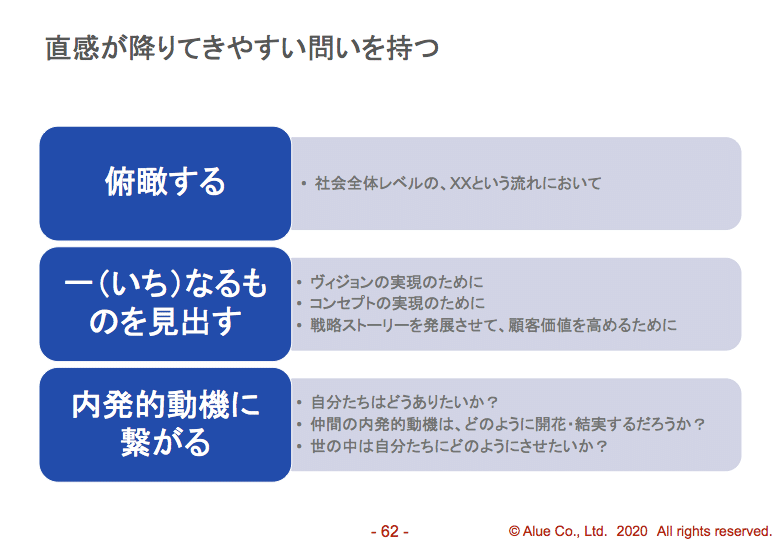
直感の重要性は、理論的にも示されている
「何となく、直感が大切ということはわかったけど、本当なのだろうか?」
そんな疑問が残っているかもしれませんね。私自身、直感というよりは思考をメインに活用しすぎるがあまり、「思考できるものが全て」という価値観を持っていた時期がありますので、そのような疑問はとても理解できます。
実は、直感の重要性は理論的にも示されています。それは、二重過程理論(Dual-Processing Theory)と呼ばれるものです。この理論において、「外部刺激に対して、人は脳内に、2種類の意思決定のシステムが同時に起こる」メカニズムが明らかにされています。
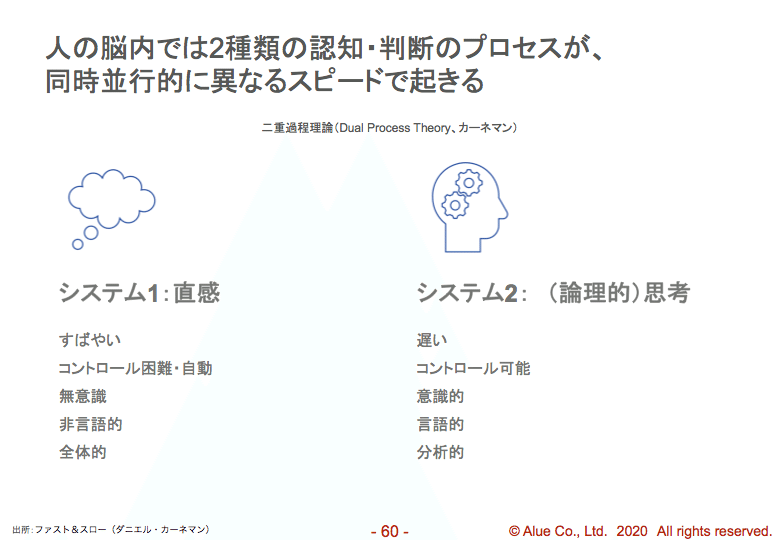
システム1が「自動的に高速で働き、努力はまったく不要か、必要であってもわずかであるような認知判断のシステム」であり、いわゆる直感です。
システム2が「複雑な計算など頭を使わなければできない困難な知的活動であり、しかるべき注意を割り当てるような認知判断のシステム」であり、いわゆる(論理的)思考です。
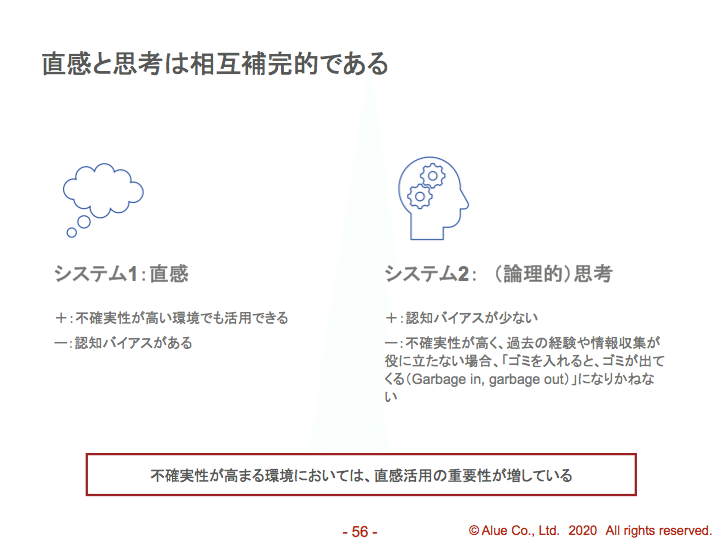
直感と思考は相互補完的です。直感は、認知バイアスといういわゆる「勘違い」を起こしやすいデメリットがある一方で、全体的に捉えた上ですばやく判断することができます。思考は、認知バイアスが少ないというメリットがある一方で、局所的な思考になりやすく、かつ、素早く判断することができません。また、前提となる情報が正しくないと、正しい判断ができないというデメリットもあります。
不確実性が高まる環境においては、直感の活用が有効となることが、最近の研究では示されています。(「世界標準の経営(入山章栄著)」にその概要がわかりやすく説明されていますので、ご興味のある方は是非)
ここまで直感活用の重要性についてお話しをしてきましたが、ビジネスの場面においては、まだまだ思考優位な世界観が主流ではないかと思います。事業計画を策定するときには、関係者にわかりやすく説明する必要があるため、どうしても思考意識中心に考えてしまいがちです。

思考意識を用いることはもちろん大切ではありますが、それだけに頼るのではなく、直感を活用することも大切であるということ、そして、戦略ストーリーにおける価値創造プロセスの始まりは直感活用であること、をこの記事ではお伝えいたしました。
次回は、直感活用について具体事例を用いながら、お話ししたいと思います。
本日の問いとなります。(よろしければ、コメントにご意見ください)
・あなたは、普段の仕事の場面において、直観と思考をどの程度のバランスで使っていますか?そのバランスは、今のままが良さそうでしょうか?あるいは、もう少しバランスを変えた方が良さそうでしょうか?そして、その理由は何ですか?
・最近、直観が降りてきたことがあるとすれば、それはどのようなことでしたか?その直観が降りてきた背景として、どのような「問い」を、意識的あるいは無意識的に持っていましたか?
How do strategic stories evolve?
In my previous article, I talked about how a concept that brings consistency to a strategic story can be created.
The starting point for the creation of new value elements in a strategic story is the awareness of a concept. In order for a new value element to be created based on that concept, several steps are required to be taken. In this article, I will explain this process.
Steps in the evolution of a strategic story and the positioning of the value creation process
First, let's review the five evolutionary steps of a strategy story to see the big picture of creating a strategy story.

In the previous articles, I have explained the steps (1) through (4) of a strategic story evolution. If you want to know more about this, please refer to this article.
After steps (1) through (4), we finally come to step (5), the "value creation" step. In order to create this value, I mentioned in my previous article that having a concept that ensures the consistency of the entire strategic story is a prerequisite.
The process of creating new value elements while connecting to a clear concept is the "value creation process". I will now talk about the "value creation process," but before I do, I think it is necessary to answer this question.
"What do we mean there is a more detailed value creation process within the steps of a strategic story evolution?"
I think it is very natural to have this kind of question. I also believe that it is important to keep things as simple as possible, rather than making things overly complicated.
However, as I mentioned in a previous article, I have decided that in order to bridge the gap between "understanding" and "creating" a good strategy, I need to describe the process in more detail in the steps of strategy story evolution
It is enough to grasp the macroscopic, consequential, and integral aspects of strategy when "understanding strategy", but when "creating strategy", it is necessary to have a microscopic, causal, and differential sense.
The following is a metaphor of traveling by car. If the destination of the trip is "to create a good strategy," it is necessary to drive the car at a certain speed in order to reach the destination. That speed is the " evolutionary steps of a strategy story. In order to drive a car at a certain speed, you need to push the acceleration pedal. The acceleration pedal is the "Value Creation Process" that I will introduce here.
Metaphorical representation of creating a good strategy as taking a trip by car
The destination of the trip (distance) - Creating a good strategy
Speed of the car (speed, first derivative): The evolutionary steps of a strategy story
Stepping on the acceleration pedal (acceleration, second derivative) ... the value creation process
In order to get to the destination of our trip, we need to step on the acceleration pedal of the car. And stepping on the acceleration pedal of a car is similar to an internal sensation, and it is something that we can do if we want to.
In the same way, I believe that creating a good strategy needs to be viewed from a microscopic, causal, and differentiated perspective, at a level close to our internal senses, as something we can do if we want to.
And I have repeatedly told you that to take a microscopic, causal, and differential view means to become aware of how we use our consciousness. The "value creation process" that I am about to explain is also viewed from the worldview of conscious management.
The six processes of value creation
The value creation process can be divided into the following six categories. The consciousness to be activated in each process is indicated by a number on the 3+1 consciousness model.
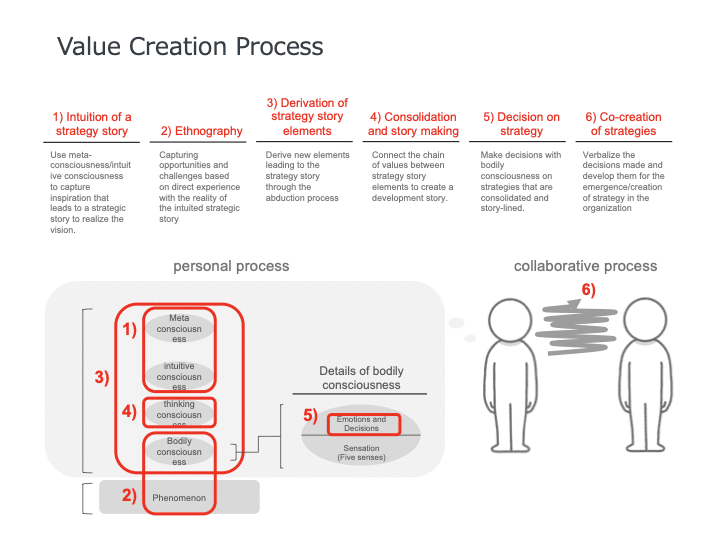
In order to understand the six processes, I would like to give an overview of each process. In addition, I would like to deepen our understanding not only by explaining the contents in an abstract way, but also by introducing specific examples.
The first step is to utilize intuition, which is the beginning of the value creation process.
It is important to use intuition to create value
1) Intuition of a strategy story :
Use meta-consciousness/intuitive consciousness to capture inspiration that leads to a strategic story to realize the vision.
The first process is to capture the spark that leads to value creation on the strategic story to realize the vision or concept (identity + core values).
"Is inspiration something we try to get intentionally?"
Many of you may be asking this question. As you say, flashes of inspiration are something that come to us and are not something that we can intentionally create right here and now. However, it is possible to make it easier to get intuition and inspiration.
The key to making it easier to get intuition and inspiration is to use our intuitive consciousness. In the 3+1 consciousness model, this corresponds to activating the intuitive consciousness. Intuitive consciousness is "the consciousness that intuitively senses the existence of essence, truth, INOCHI(life), and love. In a word, " it is the consciousness that integrates into the One."
This consciousness that integrates into the One is useful for value creation. The use of intuition was also used in the derivation of visions. Essentially, it is the same mechanism of intuition utilization.
For more information on how to use intuition in deriving visions, see the following article.
As I mentioned in the article above, have you ever done a lot of market and competitor analysis in developing a vision or strategy, only to find that the vision or strategy you came up with was uninteresting, empty, or boring?
Analyzing the market and competition is necessary when thinking about strategy. However, this is not enough to create a creative strategy story that leads to our own vision and concept. What is derived from analysis and logical thinking may provide some suggestions, but it is unlikely to lead to creative value creation.
While the thinking consciousness has the direction to understand things by "dividing" them, the intuitive consciousness has the direction to see things as a single image by "integrating and synthesizing" them. In order to conceive a strategic story and create new value, it is essential to use not only the thinking consciousness but also the intuitive consciousness.
In order to activate our intuitive awareness, we need to remove the frame of thinking consciousness that tends to be so prevalent in our daily work and prepare an environment where inspiration can come down to us.
In order to make effective use of our intuitive consciousness, it is important to have quests(questions). "How do I want to be?" "How can I integrate the contradictions? "What are the essential principles?" These quests(questions) are effective.
On the other hand, questions such as what is going on and what is the cause of the problem activate the direction of analysis and condensation, which is a characteristic of the thinking mind, so one can dare to avoid them in the intuition stage of the strategy story.

The importance of intuition has been shown theoretically
"Somehow I realized that intuition is important, but is it true?"
You may be left with such questions. I myself have gone through a period of time when I utilized thinking consciousness too much as the main tool rather than intuition, and had a value system that "everything is what can be thought", so I understand such questions very well.
In fact, the importance of intuition has also been shown theoretically. It is called the Dual-Processing Theory. In this theory, it is revealed that "in response to external stimuli, two types of decision-making systems occur simultaneously in the human brain."
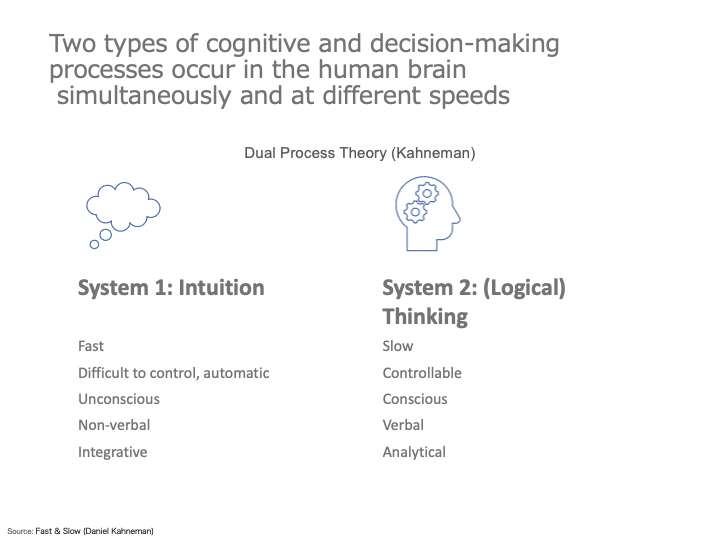
System 1 is "a system of cognitive judgments that work automatically and at high speed, requiring no effort at all or very little if any," which is what we call intuition.
System 2 is "a system of cognitive judgment that allocates appropriate attention to difficult intellectual activities that require the use of the brain, such as complex calculations," which is so-called (logical) thinking.

Intuition and thinking are complementary. Intuition has the disadvantage of being prone to cognitive bias, which is the tendency to make mistakes, but it also allows us to take a holistic view and make quick decisions. Thinking has the advantage of being less prone to cognitive bias, but it tends to be localized and does not allow for quick decisions. It also has the disadvantage of not being able to make correct judgments if the information it assumes is not correct.
In an environment of increasing uncertainty, recent research has shown that the use of intuition can be effective. (For those who are interested, please refer to "Management Theory of the Global Standard (by Shoei Iriyama)" for an easy-to-understand overview.
I have talked about the importance of using intuition, but I believe that in the business world, a thinking-dominant worldview still prevails. When we formulate a business plan, we need to explain it in a way that is easy to understand to the people involved, so we tend to think in a thinking-centered way.
While it is of course important to use our thinking consciousness, it is also important to use our intuition, and the value creation process in a strategic story starts with the use of intuition.
In my next article, I would like to talk about the use of intuition, using specific examples.
Here are the quests of the day. (If you'd like, please share your thoughts in the comments.)
・What is the balance between your intuition and your thinking in your daily work situations? Do you think the balance is good as it is now? Or would you like to change the balance a little more? And what are the reasons?
・What, if anything, has your intuition been telling you lately? What "quests(questions)" have you been consciously or unconsciously asking yourself as a background to that intuition?
Bunshiro Ochiai
この記事が気に入ったらサポートをしてみませんか?
